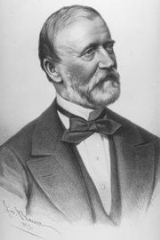
Engerth locomotive
Encyclopedia
The Engerth locomotive was a type of early articulated
steam locomotive
designed by Wilhelm Freiherr von Engerth for use on the Semmering Railway
in Austria.
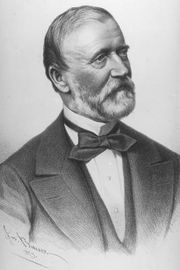 Wilhelm von Engerth was born in Pless, Upper Silesia
Wilhelm von Engerth was born in Pless, Upper Silesia
(Now Pszczyna, Poland) on 26 May 1814, the brother of the artist Edouard von Engerth. Initially, he studied architecture, but in 1834 he took up mechanical engineering as a profession. By the late 1850s he was the General Manager of the Imperial Austrian State Railways
. Von Engerth was created a Baron
(Freiherr
) in 1875, and he died on 4 September 1884 in Leesdorf.
on 11 December 1852.
, opened on 17 July 1854, was one of the first true mountain railway
s, traversing a section of the Austrian Alps
. It was characterized by steep gradients and sharp curves. To work this railway a new design of locomotive was developed.
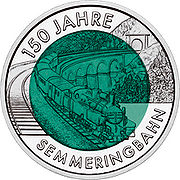 A competition was held to decide which locomotives would be bought for operation on the Semmering Railway. One stretch of the line had gradients of 1 in 40 (2.5%) and curves with a minimum radius of 190 metres (207.8 yd) and a maximum radius of 285 metres (311.7 yd). A speed of 11.5 kilometres per hour (7.1 mph) was required to be maintained and a maximum axle loading of 14 tonnes, with a boiler pressure not exceeding 8.5 kgf/cm² (830 kPa). There were four entrants, Bavaria, built by Maffei; Weiner-Neustadt built by Weiner-Neustadt; Seraing built by Société anonyme John Cockerill in Belgium and Vindobona built by the Glognitz Bahn in Vienna
A competition was held to decide which locomotives would be bought for operation on the Semmering Railway. One stretch of the line had gradients of 1 in 40 (2.5%) and curves with a minimum radius of 190 metres (207.8 yd) and a maximum radius of 285 metres (311.7 yd). A speed of 11.5 kilometres per hour (7.1 mph) was required to be maintained and a maximum axle loading of 14 tonnes, with a boiler pressure not exceeding 8.5 kgf/cm² (830 kPa). There were four entrants, Bavaria, built by Maffei; Weiner-Neustadt built by Weiner-Neustadt; Seraing built by Société anonyme John Cockerill in Belgium and Vindobona built by the Glognitz Bahn in Vienna
. All four locomotives fulfilled the conditions of the trial, but did not prove reliable in practice. The Semmering Trials lead to a number of developments in locomotive design:- Fairlie
's Patent of 1863, The Meyer locomotive
and the Mallet locomotive
.
The Engerth design articulated the tender
with the main locomotive frame, allowing some of the weight of the fuel and water to be carried on the driving wheel
s to improve adhesion
. Because the tender was articulated, rather than directly attached to the frame, the locomotive could traverse relatively sharp curves, while still enjoying the advantage of the additional adhesive weight gain. The original design also included an indirect drive from the main driving wheels to the wheels under the tender. This arrangement proved too complex to maintain and was dropped from the design.
Sixteen locomotives were supplied to the Semmering Railway between November 1853 and May 1854. They proved capable of 19 kilometres per hour (11.8 mph) uphill on gradients of 1 in 40 (2.5%). An Engerth locomotive was featured on an Austrian stamp commemorating the 150th anniversary of the Semmering Railway in 2004. The Engerth locomotive also appeared on a 25 Euro coin issued by Austria in 2004.
 The design proved popular, especially for use in Alpine mountain railways. Engerth locomotives were found with wheel arrangements of 0-4-4
The design proved popular, especially for use in Alpine mountain railways. Engerth locomotives were found with wheel arrangements of 0-4-4
T, 0-4-6
T, 2-6-2
T, 0-6-4
T, 0-8-4
T and 0-8-6
T. As well as in Austria, they were used in Bosnia and Herzegovina
, France, Italy, Java, Romania, Spain and Switzerland. Krauss
of Munich
built ten locomotive for the Ponferrada
- Villablino
railway (PV) in Spain. Some narrow gauge 2-6-0T locomotives were built for the Ferrocaril de Elgoibar
a San Sebastián
. These powerful locomotives were capable of 60 kilometres per hour (37.3 mph) and could traverse curves of 100 metres (109.4 yd) radius. Two of these locomotives were later sold to the PV. Another four locomotives built by MACOSA
in Spain were also bought by the PV. Three of the PV locomotives were in service until 1989. Thirteen Engerth locomotives were supplied to the Oraviţa
- Bazias railway in Romania in 1854.
No.4270.
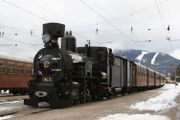
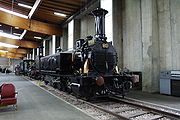 One example of the Engerth type is preserved at the Swiss Transport Museum
One example of the Engerth type is preserved at the Swiss Transport Museum
in Lucerne
. This locomotive, No.28 Genf an 0-4-6T built by Maschinenfabrik Esslingen
in 1858 to work the Schweizensche Centraalbahn (Swiss Central Railway). She retired from active service in 1899 and was used as a static boiler at Olten
. She is the oldest locomotive in Switzerland.
Buštěhradská dráha (Buštěhrad
Railway) locomotive 103 Kladno is preserved in the National Technical Museum
in Prague
, Czech Republic
.
All six of the narrow gauge NÖLB Mh or 399 class Engerth locomotives survive in Austria. These 760mm gauge 0-8+4 (D2h2t) locomotives were built by Krauss for the Mariazellerbahn
in 1906 and 1908. When the Mariazellerbahn was electrified the Niederosterreichische Landesbahn (NOLB) transferred them to their Waldviertler Schmalspurbahnen system at Gmund. When the ÖBB
took over in 1922 the locomotives were redesignated the 399 class.
Mh1 / 399.01 (5431/1906) is part of the ÖBB
heritage fleet. It is currently based at Gmund ,ÖBB-Erlebnisbahn.
Mh2 / 399.02 (5432/1906) is part of the ÖBB
heritage fleet. It is currently based at Gmund ,ÖBB-Erlebnisbahn.
Mh3 / 399.03 (5433/1906) was sold to the Pinzgauer Lokalbahn
. It is currently based at Zell-am-Zee.
Mh4 / 399.04 (5434/1906) is part of the ÖBB
heritage fleet. It is currently based at Gmund ,ÖBB-Erlebnisbahn.
Mh5 / 399.05 (5924/1908) is privately owned. It is currently based at Heidenreichstein on the Waldviertler Schmalspurbahnverein (WSV)
Mh6 / 399.06 (5925/1908) is preserved on the Mariazellerbahn
in Austria.
Chemin de Fer du Midi
0-6-4T locomotive no.312 L'Adour is preserved at the Musée Français du Chemin de Fer
, Mulhouse
, France.
has Gem, an Engerth type locomotive on its gauge line.
Articulated locomotive
Articulated locomotive usually means a steam locomotive with one or more engine units which can move independent of the main frame. This is done to allow a longer locomotive to negotiate tighter curves...
steam locomotive
Steam locomotive
A steam locomotive is a railway locomotive that produces its power through a steam engine. These locomotives are fueled by burning some combustible material, usually coal, wood or oil, to produce steam in a boiler, which drives the steam engine...
designed by Wilhelm Freiherr von Engerth for use on the Semmering Railway
Semmering Railway
The Semmering railway, Austria, which starts at Gloggnitz and leads over the Semmering to Mürzzuschlag was the first mountain railway in Europe built with a standard gauge track. It is commonly referred to as the world's first true mountain railway, given the very difficult terrain and the...
in Austria.
Designer

Upper Silesia
Upper Silesia is the southeastern part of the historical and geographical region of Silesia. Since the 9th century, Upper Silesia has been part of Greater Moravia, the Duchy of Bohemia, the Piast Kingdom of Poland, again of the Lands of the Bohemian Crown and the Holy Roman Empire, as well as of...
(Now Pszczyna, Poland) on 26 May 1814, the brother of the artist Edouard von Engerth. Initially, he studied architecture, but in 1834 he took up mechanical engineering as a profession. By the late 1850s he was the General Manager of the Imperial Austrian State Railways
Imperial Austrian State Railways
The Imperial Royal State Railways was the state railway organisation in the Cisleithanian part of Austria-Hungary.-Early history:...
. Von Engerth was created a Baron
Baron
Baron is a title of nobility. The word baron comes from Old French baron, itself from Old High German and Latin baro meaning " man, warrior"; it merged with cognate Old English beorn meaning "nobleman"...
(Freiherr
Freiherr
The German titles Freiherr and Freifrau and Freiin are titles of nobility, used preceding a person's given name or, after 1919, before the surname...
) in 1875, and he died on 4 September 1884 in Leesdorf.
History
Von Engerth first patented his design for an articulated locomotiveArticulated locomotive
Articulated locomotive usually means a steam locomotive with one or more engine units which can move independent of the main frame. This is done to allow a longer locomotive to negotiate tighter curves...
on 11 December 1852.
Semmering
The Semmering RailwaySemmering Railway
The Semmering railway, Austria, which starts at Gloggnitz and leads over the Semmering to Mürzzuschlag was the first mountain railway in Europe built with a standard gauge track. It is commonly referred to as the world's first true mountain railway, given the very difficult terrain and the...
, opened on 17 July 1854, was one of the first true mountain railway
Mountain railway
A mountain railway is a railway that ascends and descends a mountain slope that has a steep grade. Such railways can use a number of different technologies to overcome the steepness of the grade...
s, traversing a section of the Austrian Alps
Alps
The Alps is one of the great mountain range systems of Europe, stretching from Austria and Slovenia in the east through Italy, Switzerland, Liechtenstein and Germany to France in the west....
. It was characterized by steep gradients and sharp curves. To work this railway a new design of locomotive was developed.

Vienna
Vienna is the capital and largest city of the Republic of Austria and one of the nine states of Austria. Vienna is Austria's primary city, with a population of about 1.723 million , and is by far the largest city in Austria, as well as its cultural, economic, and political centre...
. All four locomotives fulfilled the conditions of the trial, but did not prove reliable in practice. The Semmering Trials lead to a number of developments in locomotive design:- Fairlie
Fairlie
A Fairlie is a type of articulated steam locomotive that has the driving wheels on bogies. The locomotive may be double-ended or single ended...
's Patent of 1863, The Meyer locomotive
Meyer locomotive
A Meyer locomotive is a type of articulated locomotive. The design was never as popular as the Garratt or Mallet locomotives. It can be best regarded as 19th Century competition for the early compound Mallet and also the Fairlie articulated designs....
and the Mallet locomotive
Mallet locomotive
The Mallet Locomotive is a type of articulated locomotive, invented by a Swiss engineer named Anatole Mallet ....
.
The Engerth design articulated the tender
Tender locomotive
A tender or coal-car is a special rail vehicle hauled by a steam locomotive containing the locomotive's fuel and water. Steam locomotives consume large quantities of water compared to the quantity of fuel, so tenders are necessary to keep the locomotive running over long distances. A locomotive...
with the main locomotive frame, allowing some of the weight of the fuel and water to be carried on the driving wheel
Driving wheel
On a steam locomotive, a driving wheel is a powered wheel which is driven by the locomotive's pistons...
s to improve adhesion
Rail adhesion
The term adhesion railway or adhesion traction describes the most common type of railway, where power is applied by driving some or all of the wheels of the locomotive. Thus, it relies on the friction between a steel wheel and a steel rail. Note that steam locomotives of old were driven only by...
. Because the tender was articulated, rather than directly attached to the frame, the locomotive could traverse relatively sharp curves, while still enjoying the advantage of the additional adhesive weight gain. The original design also included an indirect drive from the main driving wheels to the wheels under the tender. This arrangement proved too complex to maintain and was dropped from the design.
Sixteen locomotives were supplied to the Semmering Railway between November 1853 and May 1854. They proved capable of 19 kilometres per hour (11.8 mph) uphill on gradients of 1 in 40 (2.5%). An Engerth locomotive was featured on an Austrian stamp commemorating the 150th anniversary of the Semmering Railway in 2004. The Engerth locomotive also appeared on a 25 Euro coin issued by Austria in 2004.
Other Engerth locomotives

0-4-4
Under the Whyte notation for the classification of steam locomotives, 0-4-4 represents the wheel arrangement of no leading wheels, four powered and coupled driving wheels on two axles, and four trailing wheels on two axles...
T, 0-4-6
0-4-6
An 0-4-6, in the Whyte notation for the classification of steam locomotives by wheel arrangement, is a locomotive with no leading wheels, four driving wheels fixed in a rigid frame, and six trailing wheels...
T, 2-6-2
2-6-2
Under the Whyte notation for the classification of steam locomotives, 2-6-2 represents the wheel arrangement of two leading wheels, six coupled driving wheels and two trailing wheels.Other equivalent classifications are:...
T, 0-6-4
0-6-4
Under the Whyte notation for the classification of steam locomotives, 0-6-4 represents the wheel arrangement of no leading wheels, six powered and coupled driving wheels on three axles, and four trailing wheels on two axles....
T, 0-8-4
0-8-4
Under the Whyte notation for the classification of steam locomotives, 0-8-4 represents the wheel arrangement of no leading wheels, eight powered and coupled driving wheels on four axles, and four trailing wheels on two axles ....
T and 0-8-6
0-8-6
An 0-8-6, in the Whyte notation for the classification of steam locomotives by wheel arrangement, is a locomotive with no leading wheels, eight driving wheels fixed in a rigid frame, and six trailing wheels...
T. As well as in Austria, they were used in Bosnia and Herzegovina
Bosnia and Herzegovina
Bosnia and Herzegovina , sometimes called Bosnia-Herzegovina or simply Bosnia, is a country in Southern Europe, on the Balkan Peninsula. Bordered by Croatia to the north, west and south, Serbia to the east, and Montenegro to the southeast, Bosnia and Herzegovina is almost landlocked, except for the...
, France, Italy, Java, Romania, Spain and Switzerland. Krauss
Krauss
Krauss is a German language surname meaning "curly", and may refer to:* Alison Krauss, an American bluegrass musician* Clemens Krauss, an Austrian conductor...
of Munich
Munich
Munich The city's motto is "" . Before 2006, it was "Weltstadt mit Herz" . Its native name, , is derived from the Old High German Munichen, meaning "by the monks' place". The city's name derives from the monks of the Benedictine order who founded the city; hence the monk depicted on the city's coat...
built ten locomotive for the Ponferrada
Ponferrada
Ponferrada is a city in the province of León, Castile and León, Spain. It lies on the Sil River, a tributary of the river Miño, in the El Bierzo valley, completely surrounded by mountains. It is the last major town along the French route of the Way of St. James before it reaches its destination...
- Villablino
Villablino
Villablino is a municipality located in the Laciana comarca, province of León, Castile and León, Spain. According to the 2004 census , the municipality has a population of 12,212 inhabitants.-See also:*Laciana* Kingdom of León...
railway (PV) in Spain. Some narrow gauge 2-6-0T locomotives were built for the Ferrocaril de Elgoibar
Elgoibar
Elgoibar is an industrial town located in the province of Gipuzkoa, in the Autonomous Community of Basque Country, northern Spain.It is located in a valley and it is traversed by the Deba river....
a San Sebastián
San Sebastián
Donostia-San Sebastián is a city and municipality located in the north of Spain, in the coast of the Bay of Biscay and 20 km away from the French border. The city is the capital of Gipuzkoa, in the autonomous community of the Basque Country. The municipality’s population is 186,122 , and its...
. These powerful locomotives were capable of 60 kilometres per hour (37.3 mph) and could traverse curves of 100 metres (109.4 yd) radius. Two of these locomotives were later sold to the PV. Another four locomotives built by MACOSA
MACOSA
Material y Construcciones S.A. or MACOSA was a Spanish heavy-engineering company, mainly producing products for the rail industry. From 1989 onwards the organisation was named Meinfesa and became part of the GEC-Alstom group of companies, until 2005 when it became part of the Vossloh group as...
in Spain were also bought by the PV. Three of the PV locomotives were in service until 1989. Thirteen Engerth locomotives were supplied to the Oraviţa
Oravita
Oravița is a town in southwestern Romania, in Caraș-Severin County, with a population of 15,524 in 2000. Its theatre is a fully functional scaled down version of the Burgtheater in Vienna...
- Bazias railway in Romania in 1854.
Fink variation
A variation of the Engerth system was devised by Pius Fink. This entailed having the rear wheels also driven by coupling rods from a crankshaft, thus making the locomotive an 0-6-4-0T. One locomotive was built by the Staats Eisenbahn Gesellschaft, Vienna in 1861 carried No. 500 and was named Steyerdorf. It was used on the Reschtiza - Orawicza line. Three more were built, the last in 1867. These included No. 501 Krassova and No. 502 Gerliste. One of these four locomotives survived until 1891, becoming Hungarian State RailwaysHungarian State Railways
Hungarian State Railways is the Hungarian national railway company, with divisions "MÁV Start Zrt" and "MÁV Cargo Zrt" ....
No.4270.
Preservation


Swiss Transport Museum
The Swiss Transport Museum or Verkehrshaus der Schweiz, in Lucerne, is a museum, opened in July 1959 and exhibiting all forms of transport as well as communications...
in Lucerne
Lucerne
Lucerne is a city in north-central Switzerland, in the German-speaking portion of that country. Lucerne is the capital of the Canton of Lucerne and the capital of the district of the same name. With a population of about 76,200 people, Lucerne is the most populous city in Central Switzerland, and...
. This locomotive, No.28 Genf an 0-4-6T built by Maschinenfabrik Esslingen
Maschinenfabrik Esslingen
Maschinenfabrik Esslingen , was a German engineering firm that manufactured locomotives, tramways, railway wagons, roll-blocks, technical equipment for the railways, , bridges, steel structures, pumps and boilers.-Founding:...
in 1858 to work the Schweizensche Centraalbahn (Swiss Central Railway). She retired from active service in 1899 and was used as a static boiler at Olten
Olten
Olten is a town in the canton of Solothurn in Switzerland and capital of the district of the same name.Olten's railway station is within 30 minutes of Zurich, Bern, Basel, and Lucerne by train, and is a rail hub of Switzerland.-History:...
. She is the oldest locomotive in Switzerland.
Buštěhradská dráha (Buštěhrad
Buštehrad
Buštěhrad is a small town in Central Bohemian Region of the Czech Republic. It is located 20 km northwest of Prague and has a population of 2,295 .- External links :*...
Railway) locomotive 103 Kladno is preserved in the National Technical Museum
National Museum (Prague)
The National museum is a Czech museum institution intended to systematically establish, prepare and publicly exhibit natural scientific and historical collections. It was founded 1818 in Prague by Kašpar Maria Šternberg...
in Prague
Prague
Prague is the capital and largest city of the Czech Republic. Situated in the north-west of the country on the Vltava river, the city is home to about 1.3 million people, while its metropolitan area is estimated to have a population of over 2.3 million...
, Czech Republic
Czech Republic
The Czech Republic is a landlocked country in Central Europe. The country is bordered by Poland to the northeast, Slovakia to the east, Austria to the south, and Germany to the west and northwest....
.
All six of the narrow gauge NÖLB Mh or 399 class Engerth locomotives survive in Austria. These 760mm gauge 0-8+4 (D2h2t) locomotives were built by Krauss for the Mariazellerbahn
Mariazellerbahn
The Mariazell Railway is an electrically operated narrow-gauge railway which connects the Lower Austrian capital Sankt Pölten with the Styrian pilgrimage centre of Mariazell.- Valley Line :...
in 1906 and 1908. When the Mariazellerbahn was electrified the Niederosterreichische Landesbahn (NOLB) transferred them to their Waldviertler Schmalspurbahnen system at Gmund. When the ÖBB
ÖBB
The Austrian Federal Railways is the national railway system of Austria, and the administrators of Liechtenstein's railways...
took over in 1922 the locomotives were redesignated the 399 class.
Mh1 / 399.01 (5431/1906) is part of the ÖBB
ÖBB
The Austrian Federal Railways is the national railway system of Austria, and the administrators of Liechtenstein's railways...
heritage fleet. It is currently based at Gmund ,ÖBB-Erlebnisbahn.
Mh2 / 399.02 (5432/1906) is part of the ÖBB
ÖBB
The Austrian Federal Railways is the national railway system of Austria, and the administrators of Liechtenstein's railways...
heritage fleet. It is currently based at Gmund ,ÖBB-Erlebnisbahn.
Mh3 / 399.03 (5433/1906) was sold to the Pinzgauer Lokalbahn
Pinzgauer Lokalbahn
The Pinzgauer Lokalbahn is a narrow-gauge railway in Salzburg in Austria. The 53 kilometer railway follows the Salzach valley from Zell am See and Krimml through the Pinzgau mountains. The section between Mittersill and Krimml was damaged by flooding in 2005 and reopened in September...
. It is currently based at Zell-am-Zee.
Mh4 / 399.04 (5434/1906) is part of the ÖBB
ÖBB
The Austrian Federal Railways is the national railway system of Austria, and the administrators of Liechtenstein's railways...
heritage fleet. It is currently based at Gmund ,ÖBB-Erlebnisbahn.
Mh5 / 399.05 (5924/1908) is privately owned. It is currently based at Heidenreichstein on the Waldviertler Schmalspurbahnverein (WSV)
Mh6 / 399.06 (5925/1908) is preserved on the Mariazellerbahn
Mariazellerbahn
The Mariazell Railway is an electrically operated narrow-gauge railway which connects the Lower Austrian capital Sankt Pölten with the Styrian pilgrimage centre of Mariazell.- Valley Line :...
in Austria.
Chemin de Fer du Midi
Chemin de Fer du Midi
The Chemin de Fer du Midi, often abbreviated to CF du Midi, was an early French railway company.In 1934 it merged with the Chemin de Fer de Paris à Orléans to become part of the Chemin de Fer de Paris à Orléans et du Midi ....
0-6-4T locomotive no.312 L'Adour is preserved at the Musée Français du Chemin de Fer
Musée Français du Chemin de Fer
The Cité du train , the French national railway museum is the biggest railway museum in the world, this one being situated in Mulhouse...
, Mulhouse
Mulhouse
Mulhouse |mill]] hamlet) is a city and commune in eastern France, close to the Swiss and German borders. With a population of 110,514 and 278,206 inhabitants in the metropolitan area in 2006, it is the largest city in the Haut-Rhin département, and the second largest in the Alsace region after...
, France.
Reproduction
The Beer Heights Light RailwayBeer Heights Light Railway
The Beer Heights Light Railway operates of minimum gauge track at Beer, Devon, England. It is part of Pecorama, an exhibition owned by Peco....
has Gem, an Engerth type locomotive on its gauge line.

